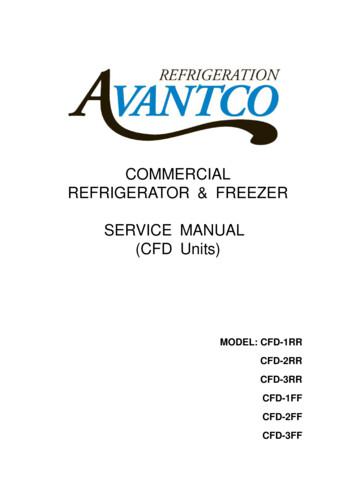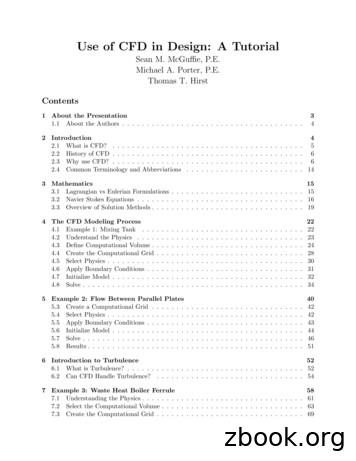CFD-Based DNB Analysis Methods
CASL Joint Industry Council / ScienceCouncil MeetingCFD-Based DNBAnalysis MethodsEmilio Baglietto, MITDave Pointer, ORNLOctober 11-12, 2016
What is challenging about DNB? why using CFD what comes to mind?Post-DNB Violent transition Complex physics Lack of understanding Decades of research “Moonshot” (Yadigaroglu, 2014)S. J. Kim (2015)An experimental study on sub-cooled flowboiling CHF of R134a ( ) what is the opportunity? New generation of experimentsPre-DNB Mature computational “framework” for CFD2
What is challenging about DNB? why using CFDNumerical CorrelationsSimply correlate data to amathematical formula Westinghouse W-3 CorrelationBiasi CorrelationBowring CorrelationMechanistic ModelsLook-Up TablesAttempts to model the physicsof the phenomenaTabulate results for all theoperating conditions Subchannel codesFLICA4, THINC, COBRA-TF Vapor ColumnZuber 1959Near Wall BubbleCrowdingWeisman & Pei1983Liquid Sublayer DryoutKatto 1994 Subchannel codesCOBRA-IIIC, COBRA-IV-I,MATRA Groeneveld CHF Look-UpTable2006, 1995, 1986Kirillov CHF Look-UpTable1991System CodesRELAP5, TRACE,CATHAREExisting models Developed a posteriori from experiments Some models do not try to model the physics at all Use of simple geometries (tubes, channels, annulus )Proof-of-Concept of DeCART/STAR-CCM /MAMBA Coupled Simulation ( ).CASL report, 2012Need for CFD approaches: Capture 3D effects (complex geometries) Incorporate first principle mechanisms for realpredictions Lack predictive power outside validated range No local surface effect (macro hydrodynamics)3
Status of DNB Capabilitiesin CFD – FY164
FY16 Completed Milestones (DNB)#1483L2:THM.P13.02BagliettoPoR-13Seung Jun KimPoR-13BuongiornoPoR-13Demonstrate DNB analysis methods using CFD (FY16.CASL.009)#1489L3:THM.CFD.P13.04LANL - DNB Assessment#1498L3:THM.CLS.P13.09Experimental study of subcooled flow boiling heat transfer up to the DNB limit for both uncoated and synthetically CRUD-ed surfaces#1503L3:THM.CLS.P13.01Balu NadigaPoR-13Hydrodynamic closure evaluation in multiphase flow using STAR-CCM and NEPTUNE#1493L3:THM.CLS.P13.03Junsoo Boiling Validation against TAMU Data#1492L3:THM.CLS.P13.05Robust hydrodynamic closures advancements for PWR application.#1497L3:THM.CLS.P13.08Device-Scale Multiphase Flow Experiments and Data Analysis#1500L3:THM.CFD.P13.01Analyze Mechanistic Models of Subcooled Boiling and CHF in LWR Fuel Assemblies with Spacers#1495L3:THM.CLS.P13.02LuoPoR-13Advanced Boiling Algorithms [Test bed openFOAM]5
GEN-I and GEN-II DNB methods in CFDmulti-step and multi-approach Based on validated GEN-I Hydrodynamicclosures – Extensive completion / validation activities Currently working on 5x5 performanceevaluationGEN-II Hydrodynamic Closure– Lift for higher void fraction / robustness– Turbulence and wall treatment for improvedpredictions Macrolayer DNB Method implemented inSTAR-CCM (a la Weismann-Pei) Single Pipe flow DNB test performed atLANL confirm feasibility of the approachGEN-II Partitioning Completion Novel DNB resolution approach– Key to generality– Includes surface effects– Tight schedule for assessmentHeater surfaceWetted areaDryspotsJ. Jung, S. J. Kim. Observations of the CHFprocess( ) 2014Jun Kim – LANLEtienne Demarly - MITPotential CHF trigger6
GEN-I Many variants but one approach 7 DNB Forcing Function𝜱"𝒘𝒂𝒍𝒍 (𝟏 𝒇) 𝜱"𝒇𝒄 𝜱"𝒒 𝜱"𝒆𝒗 𝒇 𝜱"𝒈𝒂𝒔 A priori Heat Transfer mode transition Bubbly layer theory. Critical near-wall voidfraction α𝑐 0.82 (Weisman & Pei 1983) f smooth blending function between 0 and α𝑐 : average void fraction in the near wall cell7
GEN-I attempts at calibration 8 Low errors in optimized cases High errors non standard cases High sensitivity on: Mesh Physics models Could be partly related to limitations of theHydrodynamic closuresComputational multi-fluid dynamics predictions of critical heat flux in boiling flow. S. Mimouni. 20148
1. Implementation of “Gen I” DNB ModelLANL in charge ofassessment will presentcurrent statusCurrently working on 5x5application0.025 Lift CoefficientNo Lift Single tube (8mm) Pressure: 100 bar Inlet quality: -0.24 Inlet mass flux: 3000 m2 s Constant heat flux Reference CHF: Groeneveld 2006 Constant liftkgIncoming Flowq”𝑄𝐶𝐹𝐷 4.35MW𝑄𝐿𝑈𝑇 5.189MW𝜺 𝟏𝟔. 𝟐%q”𝑄𝐶𝐹𝐷 5.04MWQ LUT 4.666MW𝜺 𝟖%-0.025 Lift Coefficientq”Outlet Boundary𝑄𝐶𝐹𝐷 5.0MW (no DNB)𝑄𝐿𝑈𝑇 𝜺 𝟑𝟎%9
CFD methodology for DNB model andboiling curve generationCFD methodology for DNB modelWall temperature monitoring7004.0E6Wall superheated temperature [K]heat flux .0E6Applied heat flux [W/m2]680Wall temperature [K]Boiling curve with DNB n Kim – LANL , Etienne Demarly - MIT10
Calculated Critical Heat Flux by LANL (MW/m2)Preliminary result for DNB validation in M-CFD65P 138 barG 940 2650 kg/m2s Tsub 10-100KD 7.7mm4 20 %3-20 %21123456Measured Critical Heat Flux by ANL (MW/m2) Show reasonable agreement between Exp. and CFD Best prediction with current boiling model at high mass flux & low subcooled flowJun Kim – LANLEtienne Demarly - MIT11
PWR Fuel Geometries Curently starting evaluatingmodel applicability and BPGfor 5x5 assemblyboiling heat transfervoid fractionDNB12
Challenges of “industrial” application13
Challenges of “industrial” application14
DNB Experimental ObservationMicro/nano surface CHF enhancementsMacro vs Micro thermal hydraulic origin of DNBB. Kim, H. Lee. Interfacial wicking dynamics ( ) 2014Dry Area FractionY. Liu, M. Srivastava, N. Dinh. CASL Report: L3:THM.CLS.P9.06J. Jung, S. J. Kim. Observations of the CHF process( ) 201415
2. Develop a consistent new DNBrepresentation in CFD based𝜱"𝒘𝒂𝒍𝒍 (𝟏 𝒇) 𝜱"𝑵𝑩 𝒇 𝜱"𝒈𝒂𝒔𝑨𝑫𝒓𝒚𝒇 𝑨𝑫𝒓𝒚 𝑨𝑾𝒆𝒕Parameters of importance for 𝒇:Heater surfaceWetted areaDry spots𝑨𝑫𝒓𝒚 𝑵" , 𝒕𝒘 , 𝒕𝒈 , 𝑫𝒅 , Surface properties (surface tension, cavities, Cp) Dry Spot clustering dynamicsPotential CHF trigger16
2. Develop a consistent newDNB representation in CFDSingle-phase (liquid) forced convectionρ𝑙 𝑐𝑝𝑙 𝑢τ"Φ𝑓𝑐 (Δ𝑇𝑠𝑢𝑝 Δ𝑇𝑠𝑢𝑏 )𝑡 17Evaporation via bubble generation4 𝐷𝑑 3"Φ𝑒𝑣 πρ𝑔 ℎ𝑓𝑔 𝑓𝑁 "32Depiction of the heat flux partitioning forsubcooled flow boiling.𝜱"𝒘𝒂𝒍𝒍 (𝟏 𝒇) 𝜱"𝒇𝒄 𝜱"𝒒 𝜱"𝒆𝒗 𝜱"𝒔𝒄 𝒇 𝜱"𝒈𝒂𝒔QuenchingΦ𝑞" ρℎ 𝑐𝑝ℎ Δ𝑇ℎ 𝑉𝑞 𝑓𝑁 "Single phase heat flux tothe gas phaseSliding conduction (sliding bubbles)2𝑘𝑙 (𝑇𝑤 𝑇𝑙 )"Φ𝑠𝑐 𝑎𝑠𝑙 𝑡 𝑓𝑁 " πη𝑙 𝑡 17
Drive development with measurementsHigh-speed IR phase detection and high-speed videopower sourceelectrodeHIGH-SPEED VIDEOliquidq′′tot , TwHSVheater radiationIR semi-transparentconductive substrateairINFRARED CAMERAmirror Average temperature and heat fluxNucleation site densityBubble departure frequencyBubble departure and lift-off diameterSliding distancePartitioned heat-fluxesq′′e q′′sc q′′q q′′fcFundamental quantitiesNd t w t g f Dd Dl hfc dsl Awet lcl 18
Examples of IR phase detection capabilitieszoom on a nucleation site19
3. GEN-II Experiment for High Heat FluxPEThER Up to10 bars Ambient temperature tosaturation 400 to 1250 kg/m2/s Up to CHF Synchronized IR and HSV Advanced post-processingalgorithmsENABLE DIRECT MEASUREMENT OF HEAT FLUX PARTITIONING20
Driven by new data analysis techniquesNucleation Sites interactionAutomatic data post-processing 21frameworkThe current best practice for NSD modeling is the Hibiki-Ishii correlation (2003). Semi-empirical modeling of cavity activations on the heater Correlation behavior is exponential by nature and unbounded. Impossible to use as-is in a numerical simulation In reality, there are only so many bubbles a surface can sustain."𝑁𝐻𝐼(Δ𝑇) 𝑒 𝑘Δ𝑇Number of activated cavities Number of active bubble generating sites.1. Creation of a metric:𝐹 𝑥, 𝑦𝑁𝑚𝑎𝑥 𝑘 0Complete Spatial Randomness:𝑃 1 𝑒 ( π𝐷𝑑Nucleation site Detection via IR postprocessing2. Gaussian smoothing (optional)2 𝑁" )3. Detection of local maxima4. Binary maskingProposed modification to Hibiki-Ishii correlation:2 ""𝑵"𝒎𝒐𝒅 Δ𝑻 𝑁𝐻 𝐼𝛥𝑇 𝑒 𝜋𝐷𝑑 𝑵𝒎𝒐𝒅𝑇 𝑥, 𝑦, 𝑘 1 𝑇(𝑥, 𝑦, 𝑡) Δ𝑡𝜟𝑻𝒅 𝑫𝒅5. Individual site frequency analysis6. Spectral analysis of the departure frequencyfor each case21
MIT Flow Boiling experiment (2013) High speed IR camera acquisition Post-processing of 𝑇 and ϕ"– Nucleation site detection– Frequency analysisTime integral of the Temperature/Heat Flux derivative (rate of change) pre/post processing22
Frequency Analysis23 From a nucleation site location: Signal extraction Detection of nucleation events Statistical analysis (mean, std) Dependency to TH conditions for thesame site Statistical distribution for each case23
FY17 elop, Demonstrate and Assess Advanced CFD-based Capability for Prediction of DNB#1660L2:THM.P15.01newR. BrewsterPoR-151-Industrial DNB Method Assessment#1661L2:THM.P15.02GEN-II DNB Method Completion and newFull Scope DNB Tests with dedicated post AR-CCM V&V Assessment Report for DNBnewPointerPoR-15#1705L3:THM.CLS.P15.02GEN-II DNB Testing and ValidationnewSeung Jun KimPoR-15#1706L3:THM.CLS.P15.03Data Driven DNB rodynamic Closures for DNBnewBagliettoPoR-1524
CHF flow boiling experiments at MITIR space resolution 100 umIR time resolution 0.4 ms2525
Growth of the dry spot at 2.45 MW/m2/K10 K subcooling, 500 kg/m2/s, 1 atm 0 ms 240 ms 480 ms 720 ms 960 ms300250200150100TEMPERATURE [ ]86420HEAT FLUX [MW/m2/K]26
www.casl.gov27
3.0E6 3.5E6 4.0E6. flux [W/m. 2] CFD methodology for DNB model Wall temperature monitoring Boiling curve with DNB point. DNB DNB. Jun Kim – LANL , Etienne Demarly - MIT. CFD
12 SR Dr.P.S. Seshadrinathan Sr DMO Cardiologist MD,DNB(CARD) Central Hospital/Perambur yes 13 SR Dr.Lakshmi GopalakrishnaSr DMO Cardiologist MD,DNB(CARD) Central Hospital/Perambur yes 14 SR Dr.P.V.Thanuja DMO Cardiologist DNB(Card),DNB(Med) Div.Hospital/Palghat No 15 WR Dr.M.V. Reddy Sr.DMO Cardiologist DNB(Card) JRH/Mumbai Central Yes Page 1
refrigerator & freezer . service manual (cfd units) model: cfd-1rr . cfd-2rr . cfd-3rr . cfd-1ff . cfd-2ff . cfd-3ff . 1 table of contents
430 allocation to elianto cfd o&m 20,577.32 440 allocation to trillium west cfd o&m 27,267.00 450 allocation to west park cfd o&m 70,008.22 460 allocation to festival ranch cfd o&m 177,790.54 480 allocation to tartesso west cfd o&m 27,809.17 481 allocation to anthem sun valley cfd o&
A.2 Initial Interactive CFD Analysis Figure 2: Initial CFD. Our forward trained network provides a spatial CFD analysis prediction within a few seconds and is visualised in our CAD software. A.3 Thresholded and Modified CFD Analysis Figure 3: Threshold. The CFD is thresholded to localise on
(DNB/MD/MS/Diploma), (between 4-10 years of service) at AFMS institutions is also available as per extant Training Rules as applicable from time to time. SSC Officers provided opportunity for In-Service PG/DNB would be liable to serve till 14 years of SSC service as per bond/undertaking executed at time of seeking placement for DNB/PG Seat.
CFD Analysis Process 1. Formulate the Flow Problem 2. Model the Geometry 3. Model the Flow (Computational) Domain 4. Generate the Grid 5. Specify the Boundary Conditions 6. Specify the Initial Conditions 7. Set up the CFD Simulation 8. Conduct the CFD Simulation 9. Examine and Process the CFD Results 10. F
performing CFD for the past 16 years and is familiar with most commercial CFD packages. Sean is the lead author for the tutorial and is responsible for the following sections: General Procedures for CFD Analyses Modeling Turbulence Example 3 - CFD Analysis
mathematics at an advanced level, including articulation to university degree study. The Unit will provide learners with opportunities to develop the knowledge, understanding and skills to apply a range of differential and integral calculus techniques to the solution of mathematical problems. Outcomes On successful completion of the Unit the learner will be able to: 1 Use differentiation .























